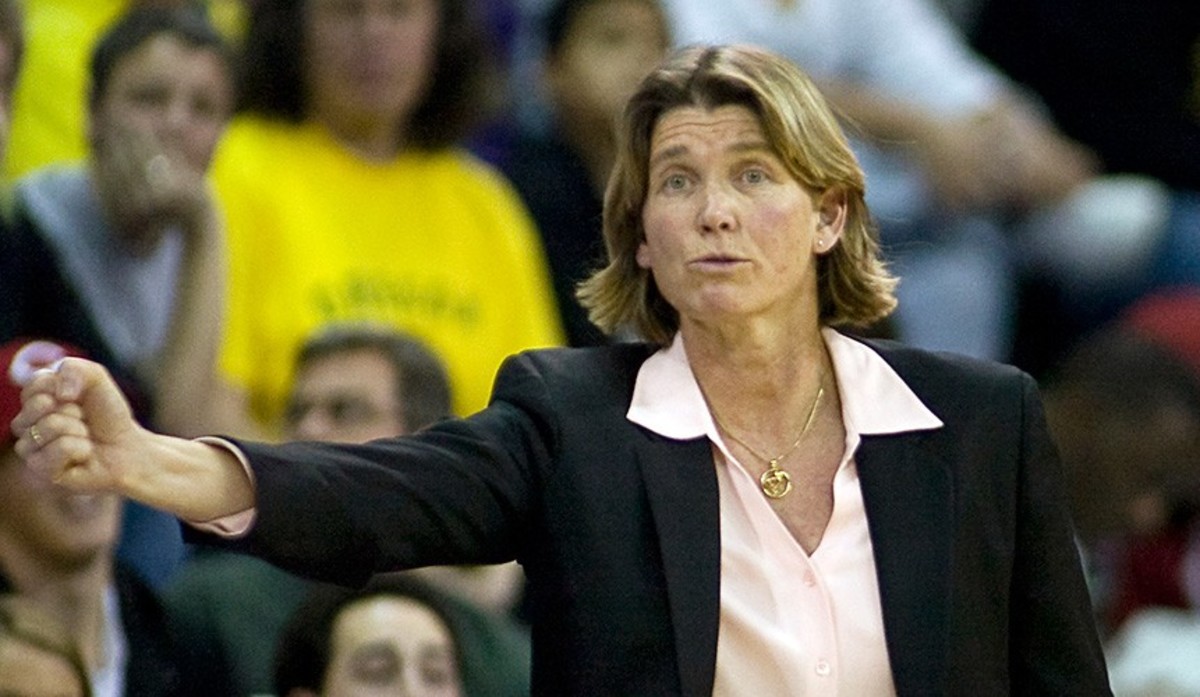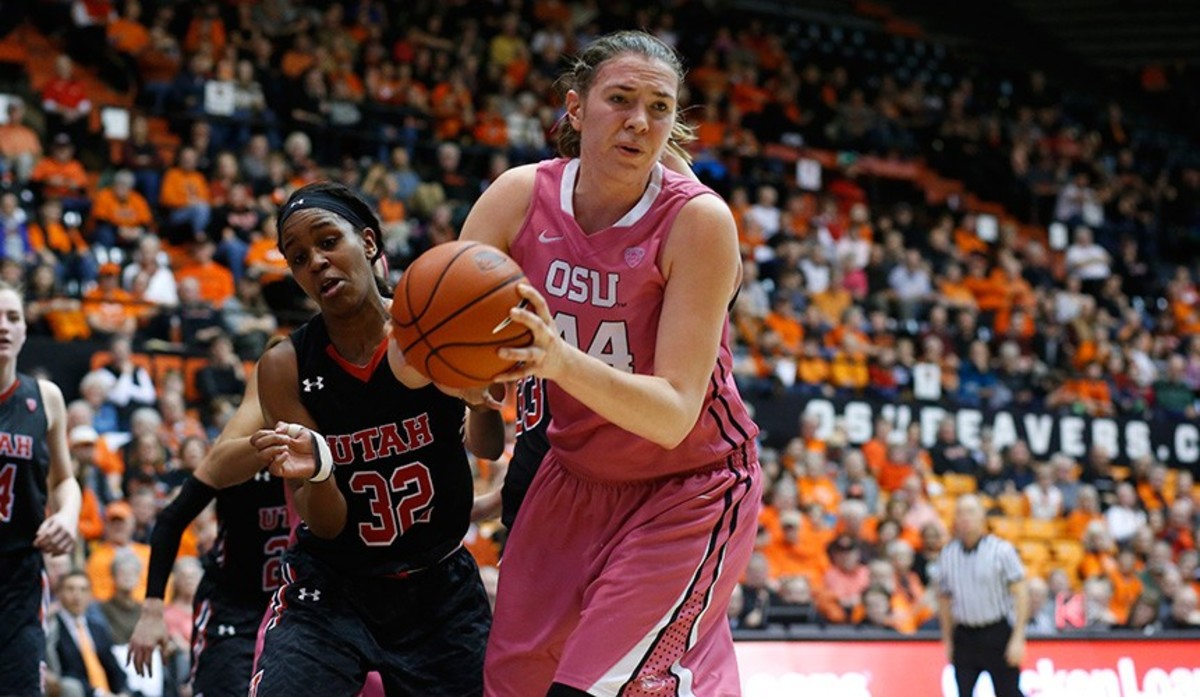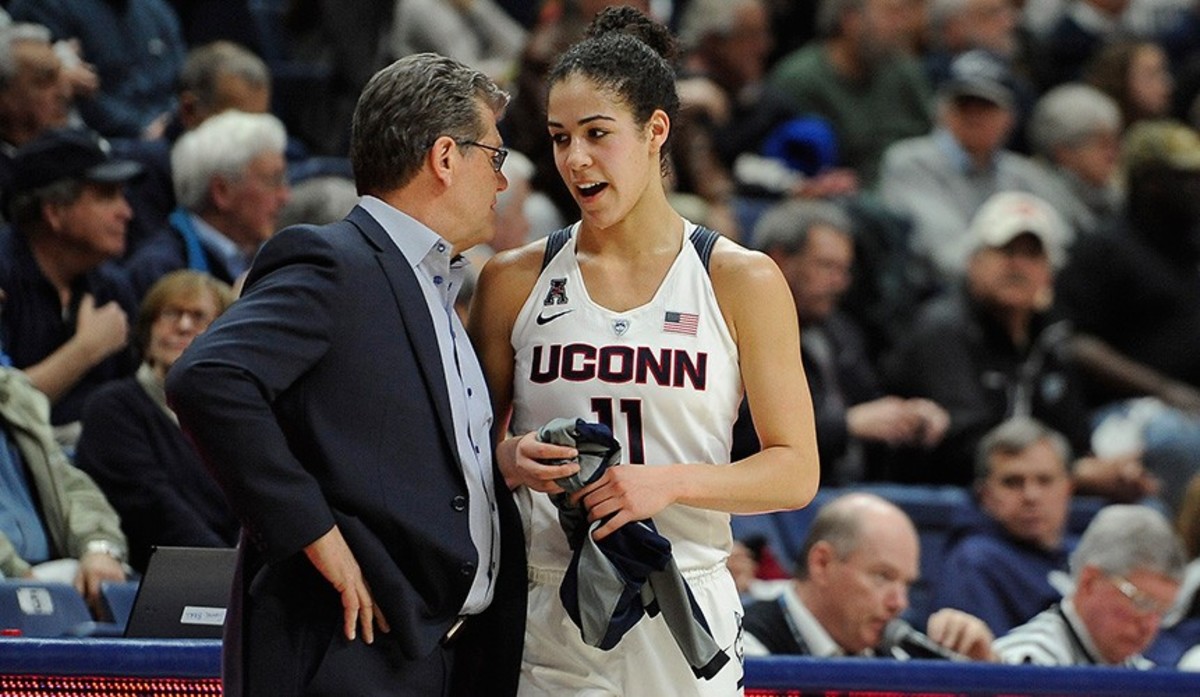How Canada Basketball has helped increase competition in U.S. women's college hoops

Growing up in Montreal, UCLA guard Nirra Fields couldn't get enough hoops. She's been a junkie since childhood, flipping the channels to study players and games. She idolized Kobe Bryant's toughness, craved Vince Carter's athleticism, and tried to mimic Steve Nash's dazzling passes.
But when it came to finding a Canadian female player she could look up to, Fields didn't have many choices. The few Canadians playing in the WNBA and women's college ball in the United States didn't get much press, and streaming games online wasn't an option then. Fields knew what she wanted to be—a college basketball player, an Olympian—she just didn't know who in her home country could be her model.
More than a decade later, finding a standout Canadian in women's college basketball isn't a problem. Fields is one of a handful of elite collegians who spends her summers with the Canadian women's national team, and will be integral in her college team's postseason success as the women's NCAA tournament begins play Friday. Canada Basketball, the players and their college coaches say, has given them access to a different level of competition—and as a result, increased their confidence. Somewhat by accident, Canada has helped increase parity in women's college hoops.
"I can't tell you the number of times I turn on the TV, and the players being profiled are Canadian," says Lisa Thomaidis, who's been working with Canada Basketball since 2001 and currently serves as head coach of the senior team. "It's pretty cool, the noise that Canadians are making, not only in our own country, but in the U.S. Some of them are having tremendous NCAA seasons. And I hope that in playing for us, they feel part of something bigger."
Fields plans to pay close attention this month to two different groups: There's her fellow Pac-12 players—the conference sent five teams to the NCAA tournament, with four earning No. 4 seeds or higher—and her Canadian teammates. Besides Fields, there's Oregon State center Ruth Hamblin and guard Jamie Weisner, Florida State center Adut Bulgak, Arizona State forward Quinn Dornstauder and Green Bay guard Kaili Lukan, among others. Even the top team in the country has gone north of the border to recruit: UConn sophomore guard Kia Nurse has started 68 of a possible 71 games in her career, last year earning American Athletic Conference freshman of the year honors. A Hamilton, Ontario, native, Nurse has played in the Canadian national system for five years, and last summer was the youngest player on the senior team that won its first senior gold in the Pan American games in July in Toronto with an 81–73 win against the United States. Nurse and her teammates followed that by qualifying for the 2016 Rio Olympics in front of their home crowd in Edmonton, winning the FIBA Americas title.
"At the international level, you learn to read and react in your offense, because you have to—you're going against the best players in the world, and your weaknesses are exposed, so you better adjust," says Nurse, who scored 33 points in the Pan Am win over the US, and averages 9.3 points and 2.7 assists for the undefeated Huskies, who are seeking their fourth consecutive title. "At UConn, it's similar in terms of making plays off of other players—and I get a lot of practice at that in the summer.
"Canada, it's a big advantage."
*****

AP file
Bev Smith has long been considered the greatest women's player in Canada basketball history. A two-time All-America at Oregon (she is still the Ducks second all-time leading scorer, with 2,063 points from 1978 to '82), Smith participated in the 1984 Los Angeles Olympics, where Canada finished fourth, and the '96 Atlanta games, where it came in 10th. She played with the senior team for 12 years and is a member of the Canadian Olympic Hall of Fame and Women's Basketball Hall of Fame. But her greatest legacy in Canada might become what she helped create for the next generation.
Shortly after being named Canada senior national team coach in 1997, Smith took stock of her situation. As she looked around the country, she realized that Canada would never be a regular contender in Olympic competition if it didn't identify and invest in its youth. In America, USA basketball relies heavily on the academic relationship with NCAA hoops—want to know who's going to be the next big star for USA Basketball? Look at Connecticut's roster, or Notre Dame's or any other elite college program. USA Basketball has the luxury of plucking top, ready-made players from the best college teams and inviting them to represent their country. The talent pool in the U.S. is so much better and deeper—especially compared to Canada—that there's little, if any, emphasis placed on youth development. USA Basketball knows that its best young players will grow through years of AAU, high school and especially college ball, with some of the game's best basketball minds tutoring teenagers. Canada doesn't have that, which played a role in the Canadians missing the 2004 and 2008 Olympics.
With Smith at the helm in '97, Canada Basketball coaches and administrators examined the "10,000-hour rule," the author Malcolm Gladwell's philosophy that the key to achieving world-class success, in any field, is 10,000 hours of practice.
"Out in the grassroots, out in the weeds, it's Mission: Impossible, because we don't have the time or facilities of other countries," says Smith, now an assistant with the senior team. "So we started to talk about, what does our Olympic-level athlete need to look like at 28, and how do we get there?"
The answer is what is now called the Targeted Athlete Strategy, where Canada recruits and identifies young talent with the goal of nurturing it mentally, physically and psychologically. Canada studied closely Australia's Institute of Sport, the training organization established in 1981 where dozens of Olympians have honed their skills. Smith says the idea of the Targeted Athlete Strategy, which has gone through "a series of evolutions" in the last 18 years, is to not focus solely on basketball ability, but overall athletic conditioning.
Canada flooded money into youth and grassroots operations. Smith jokes that the budget was so small in '97 she "can't remember that little a number," but knows a big chunk of their funds went to setting up regional basketball sites and clinics, with an emphasis on teaching fundamentals. In the immediate aftermath, the senior team suffered, because that budget could have helped them get more practice days or exhibition games. But Smith and the staff were confident there would be long-term payoff.
"We thought this could be precedent-setting,'" Smith says. "What we realized was that with more money, once our kids are giving that equal training time, they're able to compete at the highest levels, too."
*****

Timothy J. Gonzalez/AP
Ruth Hamblin was a small-town farm girl in Houston, British Columbia, with a future in rocket science when her ninth-grade chemistry teacher suggested she try basketball. "All my classmates were doing it," Hamblin says, "so I wanted to be part of the team too, right?"
As the coaching cliché goes, the benefit of being so raw and inexperienced was that Hamblin had no bad habits. She played the American equivalent of junior varsity as a freshman at Houston Christian School and after that first season, signed up for a Steve Nash youth camp. (Nash's camps are considered an offshoot of the Targeted Athlete Strategy.) There she caught the eye of Allison McNeill, the senior women's coach from 2002 to '12 who is still heavily involved with Canada Basketball. McNeill invited Hamblin to the U16 tryout, so Ruth and her father, Lance, drove 13 hours south from to Vancouver for a two-phase, two-day practice. "It was crazy overwhelming," Ruth says. "There were so many players and up to that point, at my high school, we had only ever done layup lines. Every drill was new to me."
Six years later, the 6'6" Hamblin, now a senior, anchors the best defensive team in the country, blocking 3.4 shots per game for the 28–4 Oregon State Beavers, who lead women's college basketball in field goal percentage defense (32.1%) and were award a No. 2 seed in the tournament. Hamblin's ascension directly correlates with OSU's rise to the top of the Pac-12. She has been named the conference's defensive player of the year two consecutive seasons—she owns the Pac-12 career blocks record, at 405 and counting—helping the Beavers hang back-to-back league championship banners for the first time in school history. A member of the Canada Development team that competed in the 2015 Summer Universiade in Gwangju, Korea, earning the silver medal, Hamblin also practices and plays in exhibition games with the senior team. Once star-struck by older, Canadian heavyweight like Kim Gaucher (formerly Smith, and the most decorated Canadian in women's hoops) and former Notre Dame standout Natalie Achonwa, Hamblin says "it's still so crazy" to know she's on track to be an Olympian, just like them. She's grateful for everything Canada has given her, and certainly they're thankful for what she's brought them—like her teammate from the states.
Jamie Weisner was born in Spokane, Wash., but holds dual citizenship because her father is from Vancouver. Less than two months after finishing her freshman season at Oregon State in 2013, Weisner was invited to the Canadian U19 tryout. She tagged along with Hamblin and a week after returning, got a letter from USA Basketball inviting her to their U19 tryout. After discussion with her parents and college coach Scott Rueck, Weisner turned down USA Basketball and committed to Canada. "It's a much smaller pool in Canada, that definitely played a part in it," she says now. "But more than that, Ruth was there, I already felt comfortable and there was an element of, they wanted me first."
Weisner blossomed that summer with the Canadian U19 team at the FIBA World Championships in Lithuania. Deadly off screens and terrific rebounding guard, she averaged 17.0 points, 6.4 rebounds and 2.8 assists while shooting 54.5% from the floor and accounting for 26.4% of Canada's offense. Rueck, her college coach, noticed a difference when Weisner returned to Corvallis for her sophomore year.
"Seeing yourself on the floor with some of the best players in the world, it changes you," Rueck says. "When Jamie came back, she felt like she belonged, that she could play with elite players [in college]. To take a program from nothing and build it into a program that can compete with Tennessee, Notre Dame, North Carolina, that's what Jamie and Ruth have done here—and their international experience is directly related to that."
Weisner credits Canada Basketball with increasing her basketball IQ, teaching her to adjust on the fly defensively—slowing China's frenzied pace is drastically different than handling Brazil's physicality, and there's a chance you'll play them on back-to-back days, she says—and adding stamps to her passport. Through Canada Basketball she has gained invaluable experience competing against the world's best players—and gained a major advantage in practice hours. On the men's side, top players who don't make national teams can go to summer skills camps and work on their individual game. With Canada Basketball, Weisner and other women get that same opportunity for improvement. And with that comes in a change in attitude.
"Everything I do in the summer, I bring it back to Oregon State," says Weisner, the Pac-12 player of the year who averages 17.3 points, shoots 48.6% and played sporadically with the senior team last summer. "When I line up across from someone [in the Pac-12] what I'm thinking is, 'I've been playing at the highest level six hours a day—what did you do all summer?'
"It brings out a different confidence and swagger."
****

Jessica Hill/AP
Though she stands 6-feet tall and has a reputation as a tough, physical guard, Nurse likes to call herself "the runt of the group."
The youngest player on the senior team for the last five summers, Nurse is blunt about her continued need for improvement. "Those days when I get my a-- kicked by people 10 years older than me?" she says. "Yeah, they still happen."
And she loves it. She thinks about the first time she matched up against one of her heroes, former UConn standout Maya Moore, and recalls realizing international competition with USA Basketball helped mold Moore into the type of guard who could lead UConn to back-to-back titles. Maybe her own international experience could help Nurse do the same.
She gets regular encouragement from older sister, Tamika, a former guard at Oregon and Green Bay who also spent time in the Canadian national system. (Their brother, Darnell Nurse, plays for the NHL's Edmonton Oilers.) When Tamika played at Oregon she'd often tell Smith, "Just wait till you see my little sister."
Nurse credits her maturity and college readiness to her play to Canada, and says years of international competition eased her transition into the most dominant program in women's college basketball. She comes back each summer having added something to her game; this year it was the ability to finish at the rim away from her body, all while protecting the ball. Nurse has built an especially close friendship with Fields of UCLA because, as she jokes, they're the only senior team players who aren't of the "marrying and having-a-baby age."
Fields, an All-Pac-12 selection and one half of one of the top backcourts in women's basketball, has benefitted hugely from increased time with Canada. After moving to the United States at 13, she initially played with Canada when it was convenient, prioritizing her AAU team over international tournaments. UCLA coach Cori Close saw Fields for the first time at a FIBA event in Chile in 2011, and remembers her looking uncomfortable and out of place as such a young player. Four years later, Close says Canada has played a role in Fields's "exponential growth."
"To upset the United States in your own country, in front of your family, and then to come back to college and draw from experience—how could your confidence not be high?" Close says, adding that Canada's expectation that Fields contribute prepared her for an increased role in 2015–16. She's responded, slightly increasing her scoring and rebounding averages, and lifting UCLA to a No. 3 seed in the NCAA tournament one year after they won the WNIT championship.
Fields's ability to raise expectations gets exercised in Canada, too. She and Nurse love that the country is excited about women's hoops, lauding what Fields says many people call, "the golden age of Canada basketball." Once considered an easy win, Canada now commands opponents' full attention. Nurse watched the Pac-12 title game, played in Seattle, from across the country, cheering on all her teammates—Fields, Hamblin and Weisner. Even from 3,000 miles away, she felt a connection: She empathized with defenders who tried to slow Fields one-on-one, and guards who got embarrassed when Hamblin swatted away a shot attempt. Nurse takes particular pride, she says, in an oft-overlooked country forming a special society in women's college basketball.
As for Fields, she hopes that somewhere in Montreal, there's a young, basketball-loving girl following along as Canada heads to Rio. They'll travel there in August with a bunch of homegrown players who have helped cultivate the game in the United States and more importantly, in their own country. She likes that in this era, there will be plenty of role models for that little girl.
"It's pretty cool," Fields says, "to think I could be that for someone."
